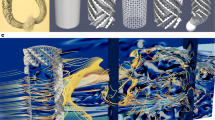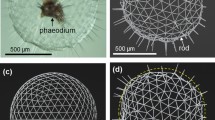Abstract
The predominantly deep-sea hexactinellid sponges are known for their ability to construct remarkably complex skeletons from amorphous hydrated silica. The skeletal system of one such species of sponge, Euplectella aspergillum, consists of a square-grid-like architecture overlaid with a double set of diagonal bracings, creating a chequerboard-like pattern of open and closed cells. Here, using a combination of finite element simulations and mechanical tests on 3D-printed specimens of different lattice geometries, we show that the sponge’s diagonal reinforcement strategy achieves the highest buckling resistance for a given amount of material. Furthermore, using an evolutionary optimization algorithm, we show that our sponge-inspired lattice geometry approaches the optimum material distribution for the design space considered. Our results demonstrate that lessons learned from the study of sponge skeletal systems can be exploited for the realization of square lattice geometries that are geometrically optimized to avoid global structural buckling, with implications for improved material use in modern infrastructural applications.
This is a preview of subscription content, access via your institution
Access options
Access Nature and 54 other Nature Portfolio journals
Get Nature+, our best-value online-access subscription
$29.99 / 30 days
cancel any time
Subscribe to this journal
Receive 12 print issues and online access
$259.00 per year
only $21.58 per issue
Buy this article
- Purchase on SpringerLink
- Instant access to full article PDF
Prices may be subject to local taxes which are calculated during checkout





Similar content being viewed by others
Data availability
Raw data for the plots are available on GitHub at http://fer.me/sponge-structure. Additional data that support the findings of this study are available from the corresponding authors on request.
Code availability
All codes necessary to reproduce results in main paper are available on GitHub at http://fer.me/sponge-structure.
References
Schulze, F. E. Report on the hexactinellida collected by H.M.S. Challenger during the years 1873–76. In Report on the Scientific Results of the Voyage of H.M.S. Challenger During the Years 1873–76 (eds Thomson, C. W. & Murray, J.) Zoology Vol. 21, 1–513 (Neill and Co., 1887).
Aizenberg, J. et al. Skeleton of Euplectella sp.: structural hierarchy from the nanoscale to the macroscale. Science 309, 275–278 (2005).
Weaver, J. C. et al. Unifying design strategies in demosponge and hexactinellid skeletal systems. J. Adhes. 86, 72–95 (2010).
Miserez, A. et al. Effects of laminate architecture on fracture resistance of sponge biosilica: lessons from nature. Adv. Funct. Mater. 18, 1241–1248 (2008).
Monn, M. A., Weaver, J. C., Zhang, T., Aizenberg, J. & Kesari, H. New functional insights into the internal architecture of the laminated anchor spicules of Euplectella aspergillum. Proc. Natl Acad. Sci. USA 112, 4976–4981 (2015).
Schaedler, T. A. et al. Ultralight metallic microlattices. Science 334, 962–965 (2011).
Ashby, M. F. The properties of foams and lattices. Phil. Trans. R. Soc. Lond. A 364, 15–30 (2006).
Evans, A. G., Hutchinson, J. W., Fleck, N. A., Ashby, M. F. & Wadley, H. N. G. The topological design of multifunctional cellular metals. Prog. Mater. Sci. 46, 309–327 (2001).
Phani, A. S., Woodhouse, J. & Fleck, N. A. Wave propagation in two-dimensional periodic lattices. J. Acoust. Soc. Am. 119, 1995–2005 (2006).
Lu, T. J., Stone, H. A. & Ashby, M. F. Heat transfer in open-cell metal foams. Acta Mater. 46, 3619–3635 (1998).
Ashby, M. F., Seymour, C. J. & Cebon, D. Metal Foams and Honeycombs Database (Granta Design, 1997).
Evans, A. G., Hutchinson, J. W. & Ashby, M. F. Multifunctionality of cellular metal systems. Prog. Mater. Sci. 43, 171–221 (1998).
Deshpande, V. S., Ashby, M. F. & Fleck, N. A. Foam topology: bending versus stretching dominated architectures. Acta Mater. 49, 1035–1040 (2001).
Gibson, L. J. & Ashby, M. F. Cellular Solids: Structure and Properties (Cambridge Univ. Press, 1999).
Phani, A. S. & Hussein, M. I. Dynamics of Lattice Materials (John Wiley & Sons, 2017).
Danielsson, M., Parks, D. M. & Boyce, M. C. Three-dimensional micromechanical modeling of voided polymeric materials. J. Mech. Phys. Solids 50, 351–379 (2002).
Bertoldi, K. & Boyce, M. C. Mechanically triggered transformations of phononic band gaps in periodic elastomeric structures. Phys. Rev. B 77, 052105 (2008).
Hansen, N., Akimoto, Y. & Baudis, P. CMA-ES/pycma: r3.0.3. https://doi.org/10.5281/zenodo.2559634 (2019).
Horne, M. R. & Merchant, W. The Stability of Frames (Elsevier, 1965).
Schulze, F. E. Hexactinellida. In Scientific Results of the German Deep-Sea Expedition with the Steamboat, Valdivia 1898–1899 (ed. Chun, C.) (Gustav Fischer, 1904).
Saito, T., Uchida, I. & Takeda, M. Skeletal growth of the deep-sea hexactinellid sponge Euplectella oweni, and host selection by the symbiotic shrimp Spongicola japonica (crustacea: Decapoda: Spongicolidae). J. Zool. 258, 521–529 (2002).
Walter, S. L., Flinn, B. D. & Mayer, G. Mechanisms of toughening of a natural rigid composite. Mater. Sci. Eng. C 27, 570–574 (2007).
Monn, M. A., Vijaykumar, K., Kochiyama, S. & Kesari, H. Lamellar architectures in stiff biomaterials may not always be templates for enhancing toughness in composites. Nat. Commun. 11, 373 (2020).
Woesz, A. et al. Micromechanical properties of biological silica in skeletons of deep-sea sponges. J. Mater. Res. 21, 2068–2078 (2006).
Acknowledgements
This work was supported by NSF-GRFP Fellowship Grant Number DGE-1144152 (M.C.F.), a GEM Consortium Fellowship (M.C.F.) and the Harvard Graduate Prize Fellowship (M.C.F.), and was partially supported by the NSF through the Harvard University Materials Research Science and Engineering Center Grant Number DMR-2011754 and NSF DMREF Grant Number DMR-1922321. We also thank J. R. Rice, J. W. Hutchinson, F. H. Abernathy, J. Vlassak, S. Gerasimidis and C. Rycroft for discussions.
Author information
Authors and Affiliations
Contributions
All authors secured research funding. K.B. and J.C.W. supervised the research. M.C.F. and J.C.W. generated models and performed mechanical testing and finite element simulations. M.C.F., K.B. and J.C.W. analysed the data. All authors wrote the paper.
Corresponding authors
Ethics declarations
Competing interests
The authors would like to disclose a submitted patent application on related geometric features reported in this manuscript. United States Patent and Trademark Office (USPTO) (RO/US) application number: 002806-094100WOPT filed in 2019. Patent applicant: President and Fellows of Harvard College. Inventors: Matheus C. Fernandes, James C. Weaver, and Katia Bertoldi. The authors declare no further competing interests.
Additional information
Publisher’s note Springer Nature remains neutral with regard to jurisdictional claims in published maps and institutional affiliations.
Supplementary information
Supplementary Information
Supplementary Figs. 1–27, Tables 1–3 and Sections 1–5.
Rights and permissions
About this article
Cite this article
Fernandes, M.C., Aizenberg, J., Weaver, J.C. et al. Mechanically robust lattices inspired by deep-sea glass sponges. Nat. Mater. 20, 237–241 (2021). https://doi.org/10.1038/s41563-020-0798-1
Received:
Accepted:
Published:
Issue Date:
DOI: https://doi.org/10.1038/s41563-020-0798-1



